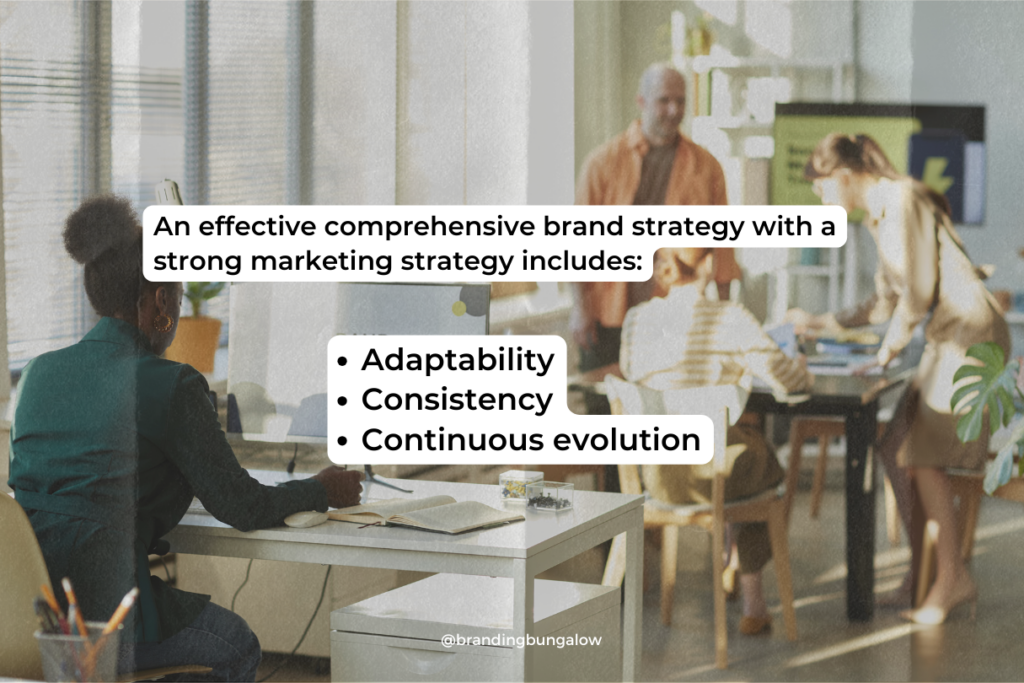Crafting a Successful Branding Strategy for Today’s Market
What makes a branding strategy succeed in today’s market, and how can you craft one that propels your business forward? This article breaks down the essential components of a successful branding strategy: defining your brand’s mission, aligning with core values, and positioning effectively against competitors. Discover practical steps to embed your branding across marketing efforts and measure success, without losing sight of what makes your brand unique.
Key Takeaways
- A successful brand strategy is more than logos or taglines. It is a comprehensive approach encompassing the brand’s mission, values, adaptability, consistency, and continuous evolution to connect with consumers.
- The brand’s identity is built on foundational pillars such as the mission statement, core values, and persona. These pillars guide all internal and external communications and shape customers’ perceptions.
- Effective brand positioning requires differentiating the brand in the market, a deep understanding of the target audience, and leveraging market research for strategic insights to craft a unique brand narrative.
Decoding Brand Strategy: What It Means for Your Business

Every successful brand is anchored by a robust strategy – a blueprint that outlines its path to recognition and loyalty in the market. Think of it as a business’s DNA, encoding everything the brand stands for and how it communicates with the world. It’s not just about having a great logo or a catchy tagline. It’s about weaving a comprehensive tapestry that includes a brand’s mission, values, and unique story.
An effective comprehensive brand strategy exhibits a successful brand strategy with a strong brand marketing strategy, including:
- Adaptability, adjusting to market trends
- Consistency in message that emotionally connects with consumers
- Continuous cycle of evolution to remain relevant and compelling.
The Pillars of Brand Identity

Peeling back the layers of a brand uncovers its core elements: a mission statement, core values, and a brand persona. These pillars are the bedrock of a brand’s identity, shaping the way it’s perceived and the manner in which it interacts with the world. They’re not just words on a page; they are the guiding principles that inform every marketing campaign and customer interaction, ensuring that the brand’s voice remains true and recognizable in a sea of competition.
Mission Statement: Your Brand’s Guiding Light
A mission statement is the compass that guides a brand’s strategic decisions and actions. It’s the brand’s raison d’être, succinctly expressing why it exists and what it strives to achieve. This pivotal statement is a rallying cry that unites the team and aligns them with the brand’s overarching goals.
Rather than being static, the mission statement changes in tandem with the brand. It should maintain its purpose relevant amid changing business landscapes. It’s a declaration of intent that reflects the ethical stance of the brand, setting the tone for its future.
Core Values: The Heartbeat of Your Brand
The heartbeat of a brand lies in its core values, which echo the character traits and ethical standards it embodies. These values are the brand’s moral compass, guiding its communication and behavior, ensuring that every touchpoint reflects the brand’s true character. They foster a culture of unity within the organization and resonate with customers who share similar beliefs, creating a bond that goes beyond transactional interactions. Some key core values that a brand may embody include:
- Integrity
- Innovation
- Sustainability
- Customer-centricity
- Collaboration
These core values serve as a foundation for the brand’s identity and help shape its decisions and actions. By staying true to its core values, a brand can build trust and loyalty among its customers and stakeholders.
When core values are clearly communicated, they translate into a consistent brand experience that builds trust and loyalty. This consistency paves the way for long-term success.
Brand Persona: Crafting Your Brand’s Personality
Breathing life into a brand, the brand persona endows it with a relatable human touch. It’s a carefully constructed character that embodies the brand’s values and speaks directly to the target audience, guiding how the brand expresses itself across various platforms. The persona’s traits should align with the brand’s positioning, offering a consistent narrative that captivates and engages customers.
By humanizing the brand and crafting a voice that’s distinct and familiar, a company can establish a strong brand identity, creating a meaningful connection with its audience and turning customers into loyal advocates.
Positioning Your Brand in the Competitive Landscape

Having established the identity pillars, the next step is to create a unique niche for your brand in the competitive market. Effective positioning is about differentiating your brand through a consistent narrative and a clear understanding of your mission and values. It’s a strategic play that aligns your brand’s unique value propositions with the emotional needs of your target audience, solidifying your brand’s importance in their lives.
Crafting a Unique Brand Positioning Statement
A brand positioning statement succinctly declares the brand’s unique value and its commitment to the customer. It’s about pinpointing what makes your brand stand out from the crowd and why customers should care. Crafting such a statement requires a deep understanding of your brand and the market it operates in. This understanding ensures that you can meet and exceed customer expectations.
This statement evolves with the brand, yet it consistently echoes the core values and essence that the brand stands for.
Identifying Your Target Audience
The cornerstone of any effective marketing strategy is understanding your audience, which guarantees that your message resonates and connects on a profound level. A target audience is defined by specific characteristics like location, age, and interests, which influence the creation of marketing materials that speak directly to them.
Understanding your audience’s preferences and habits allows you to tailor your marketing efforts, ensuring that your brand’s voice is heard loud and clear.
Leveraging Market Research for Strategic Insights
Acting like a compass, market research navigates your brand through the constantly changing terrains of consumer preferences and competitive landscapes. It provides a wealth of insights into what sets your brand apart, helping to avoid missteps and capitalize on unique market opportunities.
Through surveys, social listening, and data analysis, market research informs tailored branding strategies that resonate with consumers on a personal level.
Constructing a Solid Brand Marketing Strategy

After solidifying brand identity and positioning, the focus shifts to implementing a concrete brand marketing strategy. This strategy is the blueprint for how a brand communicates its message to the world. It combines the power of storytelling with the precision of data-driven decision-making. A well-executed brand development strategy ensures long-term success and growth.
Aligning Marketing Campaigns with Brand Values
Trust and customer relationships are bolstered through marketing campaigns that reflect brand values and create a cohesive narrative. They should be purposeful and impactful, demonstrating the brand’s dedication to causes and issues that resonate with its audience.
Regular reviews and refinements of brand voice and brand messaging help companies keep their campaigns relevant and aligned with their core values, contributing to effective brand development.
Utilizing Social Media for Brand Engagement
Brands leverage the dynamism of social media to engage audiences, using a variety of content strategies to ignite conversations and foster community. It’s crucial to find the right balance between authenticity and trendiness, ensuring that every post, tweet, or story contributes to a cohesive brand image.
Search Engine Optimization: Enhancing Brand Visibility
Acting as a covert mechanism, SEO thrusts a brand into consumer awareness, boosting online visibility for sustained recognition. It involves understanding your audience’s search behaviors and creating content that caters to their needs, thereby elevating your brand’s profile in the digital space.
The Art of Brand Storytelling: Engaging Your Audience

Storytelling is an ancient craft that, when applied to branding, forms a powerful means of connecting with consumers. A brand that tells a compelling story isn’t just selling a product or service; it’s sharing values, experiences, and dreams.
Developing Your Brand’s Story
A brand story is more than a narrative; it’s an invitation for the customer to embark on a journey with the brand as their guide. By understanding the customer’s desires and challenges, brands can craft stories that not only resonate but also showcase how their offerings can transform the customer’s life.
Storytelling Across Marketing Materials
When a brand’s story is woven into every piece of marketing material, it turns simple messages into memorable experiences that customers carry with them. Authenticity is key here, as stories that are true to the brand’s values and voice will strike a chord with the audience and foster a genuine connection.
Maintaining Brand Consistency: The Key to Recognition
Acting as a binding agent, brand consistency unifies the brand experience, transforming one-time buyers into lifelong patrons. Through a unified brand voice and visual identity, companies can create a seamless and recognizable brand presence across all channels.
Establishing Comprehensive Brand Guidelines
Acting as a rulebook, brand guidelines dictate how to maintain brand consistency through the use of:
- Logos
- Colors
- Fonts
- Other visual elements
They are the reference point for all marketing efforts, ensuring that every piece of content aligns with the brand’s identity and messaging.
Monitoring Brand Consistency Across Channels
To uphold brand consistency, regular audits of all branding materials and channels are vital. This ensures that every aspect of the brand, from social media, packaging, website design, advertising campaigns, and logo usage reflects the established guidelines and maintains the quality of the brand representation.
Measuring Success: Tracking the Impact of Your Brand Strategy
The last piece in the branding puzzle entails evaluating your brand strategy’s impact. This process includes monitoring consumer perceptions and marketing initiatives’ effectiveness, ensuring your brand’s health and reputation.
Customer Experience Metrics
Customer experience metrics provide valuable insights into how consumers perceive their interactions with your brand. These metrics, like CSAT and NPS, are indicators of the brand’s health and help guide future strategies to improve customer satisfaction and loyalty.
Adjusting Strategy Based on Performance
A brand strategy isn’t immutable; it needs to be flexible and responsive to performance insights. By adjusting strategies based on KPIs and customer feedback, brands can stay agile and relevant in the ever-changing market landscape.
Summary
In the dynamic world of branding, success is a blend of art and science. From crafting a brand’s core identity to weaving a captivating story and ensuring consistent experiences, a comprehensive brand strategy is pivotal to standing out. Let these insights inspire you to elevate your brand and connect with your audience like never before.
Frequently Asked Questions
What are the four 4 types of branding strategies?
There are four common brand growth strategies for businesses: line extension, brand extension, new brand strategy, and flanker/fight brand strategy. These strategies can help businesses extend their services or product offerings.
What are the 4 steps of branding?
The four key steps to branding are: understanding your company, learning your audience, selecting your brand message and positioning, and tracking brand growth. These steps are essential for successful brand development.
What is the core purpose of a brand strategy?
The core purpose of a brand strategy is to create consistency, memorability, and distinctiveness in the market by outlining the long-term plan for a brand’s identity, messaging, and positioning.
How often should a brand’s mission statement be updated?
A brand’s mission statement should be updated periodically to ensure it remains relevant as the brand evolves. This could be done annually or biennially to keep it aligned with the brand’s current goals and values.
What role do core values play in a brand’s strategy?
Core values play a crucial role in shaping a brand’s character, guiding its behavior and communication, and fostering a cohesive corporate culture and customer resonance. They influence the brand’s public portrayal and storytelling.
Recent Blog Entries
Discounts to Dubsado CRM, Helcim Payment Processing and...
Brand audits can save your business' sinking marketing ship.
What's happening to Coke and what you can learn from it.
Shop Products
Create a personalize brand board by taking elements from our 3 signature brand board templates.